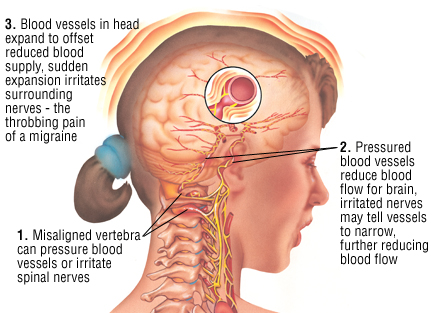Ocular migraines are migraines that cause visual disturbances, and may or may not be accompanied by pain. The symptoms can be very frightening, and can include temporary vision loss, but your vision will return to normal. Ocular migraine symptoms can last anywhere from five minutes to half an hour. even though you experience the symptoms of an ocular migraine, you should see your ophthalmologist to rule out other conditions which may threaten your vision.
How Ocular Migraines Work
Migraines occur when a blood vessel in the brain spasms. An ocular migraine occurs when that spasm affects the blood flow, and therefore oxygen flow, to the visual processing center in the brain. Migraine Headache and Tension Headaches may occur before, during, or after ocular migraines, or not at all.
Ocular Migraine Visual Symptoms
Visual symptoms may appear in one or both eyes. Symptoms of ocular migraines typically last anywhere from five to thirty minutes. Visual disturbances you may experience during an ocular migraine include:
Zigzagging lines of light
Shimmering light
Bright spot or streak of light
Flashing lights
Generalized bright light
Colored lights
A spot or spots in your vision
Tunnel vision
Blind spot
Loss of peripheral vision
Blurred central vision
Total loss of vision
Ocular Migraine Physical Symptoms
Some people experience physical symptoms in addition to visual disturbances. Often these symptoms come after the visual disturbances. They can include:
Nausea
Vomiting
Fatigue
Dizziness
Confusion
Numbness
Ocular Migraine Triggers
Nitrates and nitrites – found in processed meats, some wines, and some drinking water
Monosodium glutamate (MSG)
Fluorescent lighting, including the popular compact fluorescent bulbs
Bright sunlight
Strong odors
Excessive heat
Dehydration
Stress
Hormonal changes
Birth control drugs
Changes in barometric pressure
What to Do if You Have Ocular Migraine Symptoms
Ocular migraines will not permanently rob you of your vision, but they can be dangerous if they happen during situations like driving. The symptoms of ocular migraines can be very similar to the symptoms of other problems, including retinal tear or retinal detachment. They can also mimic the signs of stroke. even though you have never had a migraine or ocular migraine before, you should talk to your ophthalmologist or see a doctor right away to rule out something more serious.
Treatment is primarily prevention. Learning your personal triggers and avoiding them is the best way to stop ocular migraines. prescriptions are sometimes prescribed for migraines, but they are rarely effective. Many people have successfully beaten migraines with a combination of biofeedback and avoiding their triggers.

